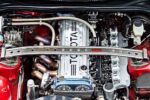Chevy 4.2 Engine Overview
A Brief History
The Chevy 4.2 engine, also known as the LL8, is a part of General Motors’ family of inline-six engines. Introduced in the early 2000s, this engine was designed primarily for the Chevrolet TrailBlazer and GMC Envoy, among other mid-size SUVs and trucks. The 4.2-liter engine was notable for its aluminum construction, which contributed to a lighter weight compared to traditional cast-iron engines, and it featured a DOHC (dual overhead cam) design that aimed to enhance performance and efficiency.
This engine was part of a broader trend in the automotive industry during the early 2000s, where manufacturers sought to balance power and fuel efficiency in response to rising fuel prices and increasing environmental regulations. The 4.2 engine was capable of producing up to 275 horsepower and 275 lb-ft of torque, making it a competitive option in its class. However, despite its initial promise, the engine has garnered a reputation for various problems that have plagued owners over the years.
As the years progressed, the 4.2 engine became synonymous with a range of issues, leading to a decline in its popularity. While it was designed to deliver a smooth driving experience and respectable towing capacity, many drivers found themselves facing unexpected repairs and maintenance costs. This paper will delve into the specific problems associated with the Chevy 4.2 engine, examining the common failures and their implications for vehicle owners. Understanding these issues is crucial for anyone considering purchasing a vehicle equipped with this engine or for those who currently own one and are experiencing difficulties.
Common Issues with the Chevy 4.2 Engine
The Chevy 4.2 engine has become notorious among vehicle owners for a variety of problems that can arise over time. While it was initially celebrated for its performance and efficiency, several design flaws and manufacturing issues have led to significant reliability concerns. Below are some of the most common problems associated with the Chevy 4.2 engine.
Oil Leaks
One of the most prevalent issues with the 4.2 engine is oil leaks. These leaks can occur due to:
- Worn gaskets
- Faulty seals
- Cracked engine components
Oil leaks not only lead to a loss of engine lubrication but can also create hazardous driving conditions if the oil drips onto hot engine parts or the road.
Head Gasket Failure
Head gasket failure is another critical issue that many owners face. This problem can manifest in several ways, including:
- Overheating
- Coolant leaks
- White smoke from the exhaust
When the head gasket fails, it can lead to severe engine damage if not addressed promptly. The cost of repairs can be substantial, often requiring a complete engine rebuild.
Timing Chain Problems
The timing chain in the 4.2 engine is known to stretch over time, which can lead to:
- Rough idling
- Engine misfires
- Difficulty starting
A stretched timing chain can result in catastrophic engine failure if the chain snaps, causing the pistons and valves to collide.
Fuel Injector Issues
Fuel injectors in the Chevy 4.2 engine can become clogged or fail, leading to:
- Poor fuel economy
- Rough engine performance
- Check engine light activation
Replacing fuel injectors can be costly, and neglecting this issue can lead to further engine damage.
Ignition System Failures
Problems with the ignition system can also plague the 4.2 engine. Symptoms include:
- Difficulty starting the engine
- Engine stalling
- Reduced power and acceleration
Issues with spark plugs, ignition coils, or wiring can lead to a complete failure of the ignition system, necessitating immediate attention.
Table of Symptoms and Consequences
| Symptom | Possible Consequence |
|---|---|
| Oil leaks | Engine damage due to lack of lubrication |
| Overheating | Head gasket failure and severe engine damage |
| Rough idling | Potential timing chain failure |
| Poor fuel economy | Increased operational costs and engine performance issues |
| Difficulty starting | Complete ignition system failure |




0 Comments